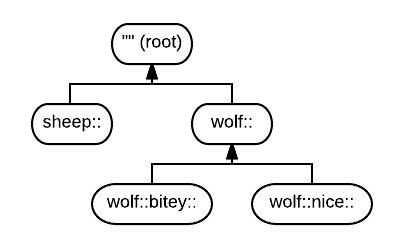ParametersTable
The following is a more detailed description of the ParametersTable class. This Page assumes you have read the pages on Parameters and Parameters Name Space.
This more detailed description describes how parameters are implemented in MABE, but ParametersLinks (PLs) provides an interface to Parameters, and so unless you are doing something extreme, the following information should not be anything you need to worry about.
ParametersTable is a class which allows MABE to store and manipulate parameters. At the core, a ParametersTable contains a look up table of parameter names to values.
Parameters are designed to be fast when reading at the expense of being relatively slow for some write operations.
Values in parameter tables can be bool, string, int or double.
If you have a parameter table called PT, you can set a value in that table with:
PT.setParameter("ParameterName",value);
The type of the parameter is determined by value.
You can read a value with one of the lookup functions. You must use the lookup function which matches the parameter type. To lookup a integer, you would use:
PT.lookupInt("ParameterName");
Parameters tables contain links to other parameters tables. Each parameter table has a link for one parent and a list of undetermined size of links for children.
A ParameterTable with no parent is a root table.
Every ParameterTable in a Parameter Tree has a name. The root tables name is "" (a blank string). each child of a root table will have a name which ends with "::". Children of non-root tables will have names that start with the parents name. In the example below, wolf::nice:: is a child of wolf::

Parameters may be set in any table. If a parameter is looked up in a table which does not have a value for that parameter, a search will be preformed up the tree until the value is found. When the value is found, a link will be established so that future lookups will be faster. This does mean that some changes to tables (in particular adding and removing parameters) require additional time to insure that the links are all correct.
When you add a new table to a parametes tree, any intermediate tables are automaticly generated. In the example above, if I only had the root table, and I added wolf::nice::, woof:: would also be added. Tables will be automaticly generated if they are needed.
You can access any part of the tree from the root. Let us assume we had a ParametersTable called root which was a root (no parent).
root.setParameter("GLOBAL-popSize",100,"dogs::big::");
root.lookupInt("GLOBAL-popSize","dogs::big::")
This would set popSize = 100 in the table called "dogs::big::" and then lookup this value.
Note that when you are writing code, you generally will not use ParameterTable::register_parameter, but instead will use Parameters::register_parameter. see Adding Parameters to Code.
register_parameter is a function used to add parameters to parameters trees.
register_parameter(const string& name, const T& default_value, const string& documentation)
register_parameter creates a parameter called name, set to default_value in both the parameters table used to call it and the root table.
Every Parameters Table has a few additional features.
- Every table has a pointer to the root table for that tree
- Every table has a pointer to a single lookup table which relates each name space and it's table (parametersTablesRegistry).
- This means that as long as you have access to any part of a parameters tree, you can quickly get anywhere else.
- a unique ID
- this integer is used to make working with and deleting child tables faster
- Every table has a pointer to a single lookup table which relates parameter with it's documentation (parameter Documentation)
- This is used when files are written.
home
welcome
MABE Parameter Widget
Installation and quick start
license
citations
release notes
developer contributions
consistency testing
Using MABE
Using Settings Files
Output Files
Creating Graphs with python
MABE framework
Defining Update
Brains
Markov Brain
Neuron Gate
Wire Brain
Human Brain
ConstantValues Brain
CGP Brain
Genetic Programing Brain
Artificial Neural Networks
Brains Structure and Connectome
Genomes
Circular Genome
Multi Genome
Genome Handlers
Genome Value Conversions
Organisms
Groups
Archivists
popFileColumns
Optimizers
Lexicase Optimizer
Worlds
Berry World
ComplexiPhi World
MultiThreadTemplate World
Utilities
DataMap
Parameters
Parameters Name Space
Adding Parameters to Code
ParametersTable
MTree
sequence function
Population Loading
PythonTools
MBuild
MGraph
MQ
findRelatedness
generatePhylogeny
Information Theory Tools
Brain States and Life Times
TimeSeries
Entropy Functions
Smearing
Fragmentation
State to State
Brain Infomation Tools
ProcessingTools